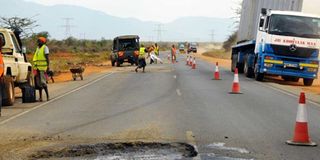The ride to Mombasa was enjoyable, till potholes from Kanu era returned

A section of Mombasa road near Maungu Town being repaired in 2013. FILE PHOTO | GIDEON MAUNDU |
What you need to know:
- I have driven on Mombasa road many times and there is no greater pleasure.
- However, Mombasa road today is worse than it has been for almost a decade.
Middle-aged men are generally irascible, so please forgive me if I shoot off my mouth too much today.
I have driven on Mombasa road many times and there is no greater pleasure.
It is a true test for man and machine; a measure of mechanical power, responsiveness, and endurance for the car and alertness, judgement, quick reflexes, and strong nerves on the part of the driver.
For a man who aspires to be a miraa pilot in retirement, I must confess that I would rather drive than fly, especially on Mombasa road.
I love the land, the ghostly baobab, the endless plateaus, the hot dusty savannah. And the people; these are my people. Five seconds after meeting, we are chatting away like family.
As an African man, I have been discriminated against in every corner of the world: from Russia to the Middle East and America.
In those parts I am an unwanted being. But here, I am a thing of this land, like those endless plateaus and hot dusty savannahs.
But there is no fun in it if there is no road. Or if the road is pot-holed. Mombasa road today is worse than it has been for almost a decade.
From Nairobi to Mtito Andei, everything is okay. If you set off before the trucks and those endless buses driven by mad people, and depending on what you are driving, you can actually, on occasion, allow the machine to clean the exhaust.
The potholes on the bad stretch of the road are deep and sharp. If you hit them at speed, you will likely be killed.
It reminded me of those last days of the 1990s when it took 11 hours — and a weapon — to drive from Mombasa to Nairobi.
When I first bought a car, I flew to Mombasa, trembling with excitement, to get it. I took a friend, with a gun, to help drive it home.
A wide-eyed young man was as likely to get shot by thieves on the road and the car stolen as get it home.
The journey was so long and so hard that I was surprised we got to Nairobi without someone getting killed by friendly fire.
Not that it mattered: I used the car for exactly two weeks. One day I woke up and it was not in the parking. It was never found.
No wonder I despised those folks in Kanu who had let things go crazy. I do hope someone will get around to fixing that road.
*******
I have given up trying to understand how Kenya is responding to the Ebola threat.
The incident at the airport when medical staff fled on seeing a bleeding, sick passenger should be a wake-up call for the complacent, ineffective, PR-mad fellows managing our medical affairs.
Seeing the Cabinet secretary with a surgical mask around his neck does not reassure anyone, other than the most feeble-minded PR adviser.
It is no protection for me, or him, against Ebola.
What I want to know, as an ordinary Kenyan who is concerned about his country’s survival, is this:
- Are there adequate and rigorously enforced procedures for screening people?
- Are there isolation facilities to receive, transport, hold, and treat patients safely?
- Are there well-trained and superbly prepared investigators to track down suspected cases?
- Is there a well-rehearsed national medical emergency response plan?
- Is there an adequate public information and civic response campaign? (Giving people the information they need to avoid infection and informing them what to do to help).
- Is there a threat map identifying the areas at greatest risk and targeted for advance stock piling of resources, including response capabilities and medicines?
- Are there teams, fully prepared and equipped with hazmat suits, at every district hospital?
I have been sending out teams of reporters to hospitals and border points to check preparedness.
Treatment of Ebola, if I am not wrong, requires intensive care units.
I do not know whether there is more than one portable negative pressure isolation bed, that thing which looks like a large caterpillar, at Kenyatta. The isolation facility is under construction.
For now, the best response is prevention: screen and quarantine uncompromisingly. At the same time, inform the public, train, retrain, and rehearse response teams. And build treatment centres across the country.
Have you done this or are you just walking around in masks?





